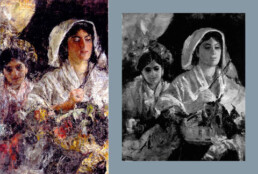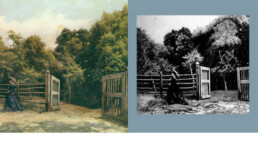TO SEEM...NOT BEING
Watchful eye against fakes
Nineteenth century collectors, who are not very practised and accustomed to a constant visual exercise, are more likely to buy a fake than people who are keen on other periods of painting. There are at least three kinds of forgery, each of them planned in a different way and with a different degree of dangerousness.

the copy: is the most common forgery, whose victims are especially inexperienced amateurs or collectors who have a limited knowledge. Nearly always the copy originates from a famous work sited in a prestigious collection or in a great museum. The copyist’s alibi consists in proposing it as a “replica” or as a “second version” escaped from cataloguing. In order to make it different from the original version, the subject is enriched with some variations which will represent its distinctive element. A simple comparison with the original will be sufficient to establish the limits of the quality and of an artificially aged support.
A. Mancini, La venditrice
total fake: is subtler it is a painting whose subject originates from the author’s free imagination but whose apparent “creative originality” never wanders from the imitated painter’s basic themes. The result is often a real iconographic assemblage made by the forger by working out details from several paintings of the same painter. The creation of the jigsaw is made difficult by the necessity for the author to identify himself completely with the imitated artist’s spirit and, of course, to be able to recreate his stylistic peculiarities.
G. Fattori, La posta al campo


period fake: è il più insidioso. It is the most deceitful since it requires a greater professionalism: it is the “period fake”, also known as “unauthorized attribution”. It consists in attributing a new, more prestigious authorship to an anonymous painting by putting the signature of a painter in greater demand on the market, over the original one.
Among the three manipulations this is the most sophisticated and the most utilized by the underworld which pollutes the nineteenth century art collecting. In order to get through the expert’s test, the forger has to choose among the huge quantity of paintings made by little-known authors, contemporaries of the artist against whom he perpetrates the abuse. The more the technical-stylistic characteristics and the composition module of the fake match the original artist, the more believable the fake will turn out to be. The final result will be an “authentic fake” , a pictorial hybrid which, owing to the ambiguous connotation given to it, will be automatically excluded from the cultural context of origin.
A. Simonetti, Ingresso alla “Vaccheria” di Capodimonte.
Napoli, Accademia di Belle Arti
